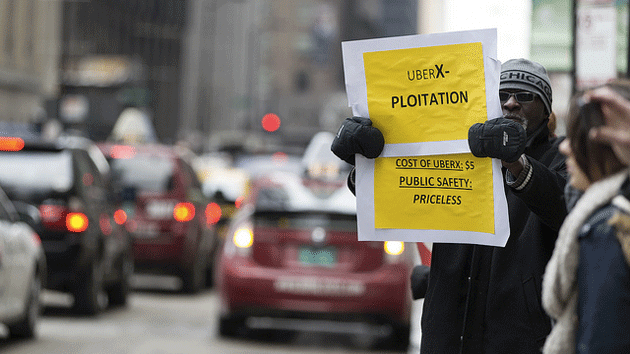
A taxi driver protests against Uber.<a href="https://www.flickr.com/photos/41802269@N03/16562371385/in/photolist-nDV7u5-nWiW4j-nWiW8Y-nW8vma-nWiVPS-nDVYS8-nWpAvR-nDUUR6-j1mV6Q-j1oDs3-tbFHW6-xgVVL9-NHsNs-rjHT6L-j1oGaC-j1jQsX-ucgNGH-di9cD1-9N39KZ-eZvekV-reytZk-ekcwki-npetiw-rDsMqr-pQJe4a-k532ma-dutDik-j6TLyN-nCerd9-oNy3zv-o7L1eJ-4MoMcL-4MAz6g-ekesN2-sjpUDf-qC14rx-otPB4L-rGUDba-rqrimu-rqriyU-reytZF-rqrj5o-85mzda-reyup8-reytNZ-cwHrHy-reyueZ-7C5tun-nEaQWp-4uPkXq">Scott L</a>/Flickr
No company right now elicits a wider range of emotions than Uber. The on-demand ride service has grown in six short years from an idea hatched by a couple of San Francisco tech bros to a $50 billion juggernaut that serves millions of users in 290 cities. Its name has not only become a verb, like that of Xerox or Google, but shorthand for an entire industry. Now an army of start-ups offers quick, cheap delivery of goods and services—everything from maids and mechanics to pizza and pot—by independent contractors tethered to smartphone apps. If you live in a major city, earn decent money, and know how to punch buttons on your phone, then you can thank Uber and its ilk for making your life a hell of a lot easier.
But that world as we know it may soon come to an end.
On Tuesday, a federal judge in San Francisco awarded class-action status to a lawsuit in which three Uber drivers contend they are employees, not independent contractors. If they win the lawsuit, the drivers must be reimbursed by the company for gas, workers compensation, and other benefits. Uber has said losing the suit, which could involve 15,000 of its former drivers, might force it to fundamentally rethink its business model. And maybe that’s exactly what needs to happen.
Uber has disrupted not just powerful taxi monopolies but also a sizeable swath of the American middle class. By flooding city streets with gypsy cabs operating under the guise of a “ride sharing” service, Uber evaded regulators, delighted consumers, and put an end to what had once been a passable way to make a living. In San Francisco, for instance, the cabbie who leads the city’s Taxi Drivers Association reported last year that his take-home pay from driving had dropped by 50 percent. Lured over to Uber by recruitment ads promising $40 an hour, many professional drivers eventually found that after paying for gas, maintenance costs, and Uber’s cut of the profits, they ultimately made less than minimum wage.
The system used by Uber and its imitators is often called the “1099 economy.” The people who work for these companies don’t file W-2 tax forms; instead, they file the independent-contractor form, the 1099-MISC. The benefits of using 1099 contractors are obvious. You only have to pay contractors for the time they spend providing services, not for lunch breaks or vacation time. You need not provide health benefits, unemployment insurance, or retirement plans. And contract workers don’t even need to be fired if they screw up, since they were never formally employed by you to begin with. You simply boot them from your app and move on.
Tech start-ups didn’t invent the 1099 economy, but they’ve dramatically expanded it. Most companies that market themselves as “Uber for __” use independent contractors, including some that are backed by tens of millions in venture capital. The dozens of 1099 start-ups in the Bay Area include Washio (Uber for laundry); Eaze (Uber for marijuana); Handy (Uber for handymen); and Spoonrocket, Postmates, and DoorDash (Uber for food).
Last year, Kevin Roose, then a writer for New York, hired a house cleaner through Homejoy, a company backed by $40 million in venture capital funding from well-respected firms such as Google Ventures. Roose asked him where he lived. “Well, right now I’m staying in a shelter in Oakland,” he said. It turned out that he was homeless, as were other Homejoy cleaners used by Roose’s friends. (In July, Homejoy shut down, citing lawsuits brought by cleaners who claimed they were misclassified as independent contractors).
Most 1099 start-ups insist their approach is better for workers. They’re typically allowed to set their own hours and, in the words of Steven Hsaio, the CEO of SpoonRocket, to become “their own entrepreneurs.” Such flexibility and autonomy might be ideal for students, artists, and anyone else looking to earn a few extra bucks in their free time, but it’s hard to see how it benefits people for whom such work is the sole means of making a living.
“If we want to live in a country where you can have a job and work 9 to 5 and have that be enough, then maybe we want to think about what these business models are doing to the larger economy,” Veena Dubal, an expert on the “sharing economy,” said recently on a San Francisco radio show.
“In the taxi industry, which Uber has effectively been trying to replace, at some point not too long ago, you had workers who were able to do this professionally,” said Dubal, an associate professor at the University of California-Hastings College of Law. “There’s something to be said for this work being professional labor and for people being able to support their families and send their kids to college and buy homes.”
In fact, a backlash against the 1099 economy is well underway. Last year, a federal appeals court ruled that 2,300 FedEx delivery drivers in California were being misclassified as independent contractors since FedEx exercised broad control over their schedules and methods. And in June, the California Labor Commissioner sided with an Uber driver who challenged his classification as an independent contractor, ruling that the company had acted like an employer by maintaining substantial control over workers’ behavior. Uber is appealing the ruling.
If Uber is forced to revamp its business model, it could spell the end of the low-cost service economy that many affluent urban consumers have come to take for granted—and a few venture capitalists might get slightly less rich. But on balance, the change will put the economy on a more sustainable track. Service workers might have a better shot at earning a living wage. And consumers will still be able to order $13 grilled Hawaiian tuna at the click of a button.
Several thriving on-demand start-ups, among them Munchery (a competitor to SpoonRocket) and Alfred (a competitor to Homejoy) treat their workers as employees and offer full-timers benefits such as health care. Others that had previously used independent contractors, such as BloomThat (Uber for flowers), Shyp (Uber for packages), and Luxe (Uber for valet parking), have recently made the switch.*
None of this means the gig economy is going away, of course. There will always be people like my friend James, a self-employed childrens’ book illustrator who has long delivered pizzas to help pay the bills. Lured by Uber’s recruitment ads, James bought a four-door Mini Cooper last spring and went to work shuttling people around. But he quickly discovered he was only making about $12 an hour, not including wear and tear on his car. So in February, James gave up the Uber gig and went back to working for the same old-school San Francisco pizza joint—where he’s classified as an employee, meaning he gets reimbursed for gas.
“A lot of people are treating Uber like a full-time job but are not getting anything from it,” he says. “I was often making twice as much delivering pizza as I was working for Uber.”
Correction: An earlier version of this article stated that Shyp and BloomThat use independent contractors. BloomThat now uses W2 employees and Shyp is in the process of making the transition. Mother Jones regrets the oversight.
















